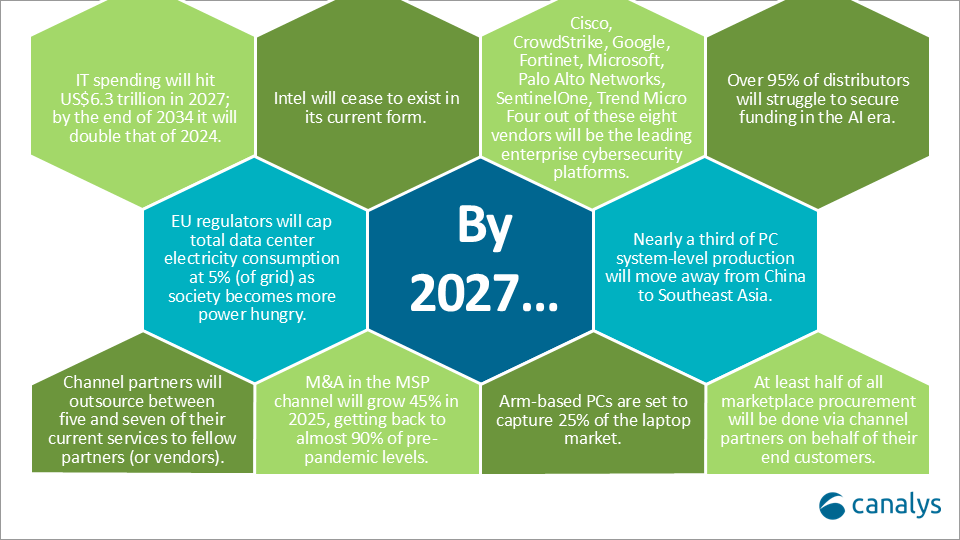Expanded Scale and Leadership in B2B: From R&D to ROI
With a combined permissioned audience of 50+ million professionals, TechTarget and Informa Tech’s digital businesses have come together to offer industry-leading, global solutions that enable vendors in enterprise technology and other key industry markets to accelerate their revenue growth at scale.

Brazil’s smartphone market to transform with the official entry of new manufacturers in 2025
Brazil’s smartphone market is poised for significant shifts in 2025 with the official entry of HONOR and vivo. This blog analyzes the challenges and opportunities for new entrants and how they can lead to market disruption, challenging established players such as Samsung, Motorola and Apple.

Brazil has become the ultimate frontier for many smartphone vendors in Latin America. With a population of 212 million and an active smartphone installed base of 175 million smartphones in 2024, Brazil is, by a large margin, Latin America’s largest smartphone market. In 2024, Brazil accounted for 29% of smartphones shipped into the region, adding over 40 million units, up over 16% compared to 2023.
The large volume potential has made Brazil a strategic and appealing market for vendors. However, high import taxes, VATs and the government’s push for local production (such as within the Manaus Free Trade Zone) challenge vendors both to enter and succeed, often resulting in few competitors, high device prices, and a requirement of significant scale to reach a sustainable long-term operation. Consequently, most vendors enter Brazil late into their expansion plans in Latin America. However, with many vendors investing dramatically in the region over the last two years, market competition may finally be on the rise again in Brazil.
Local manufacturing no longer guarantees market share
Samsung and Motorola have historically been the two market leaders in Brazil, whereas Apple has consistently dominated the premium segment. In 2024, Samsung held 39% market share, Motorola 25% and Apple 7%.
For years, these vendors have had a strong base in local manufacturing (either through direct investments or ODM partnerships), maintained competitive pricing and established strong distribution structures.
However, their market positions have been increasingly challenged in the last years amid the arrival of price-focused competitors such as Xiaomi, realme, and Infinix. Additionally, they have been challenged by a surge in the grey market from 2023 to 2024. The emerging competition has helped deliver competitive products upon demand for affordable smartphones. In 2024, shipments of devices priced below US$200 (approximately R$1,110) doubled compared to 2023 and made up 41% of total shipments.

Going ahead, vendors might continue to find opportunities with budget-friendly devices as the government seeks to increase its efforts to reduce the digital divide. In 2025, the National Digital Inclusion Plan will be developed aiming to support the 7% of the population without access to any telecommunications networks. Here, entry-level smartphones will be a needed access tool helping to grow the installed base.
New entrants will raise the stakes
Now, market competition will further intensify. In Q2 2024, OPPO entered Brazil through a partnership with Multi and has brought its Reno and A-series devices into the market. In 2025, two additional vendors will debut in Brazil - HONOR and vivo.
HONOR announced its launch in Brazil early this year. HONOR will partner with DL Eletrônicos for its local distribution and import support, which has operated as Xiaomi’s key importer and distributor in Brazil since 2019. Initially, HONOR is expected to focus on leading retail chains before expanding toward network operators, leveraging both devices in its X-series to support volume scale as well as the Magic series for brand positioning and marketing. Additionally, HONOR’s foldable Magic V3 presents the first major foldable competitor to Samsung’s Fold series, which it hopes to use to gain premium traction. For HONOR, Brazil will be a key market to strengthen its regional position in Latin America to support its overseas expansion strategy amid tough competition in its home market and IPO ambitions.
vivo, which was the largest vendor in both Mainland China and India in 2024, will enter Brazil using “JOVI” as its brand. This is because “vivo” is Telefónica’s trademark in Brazil, the country’s largest network operator. Although its official plans remain somewhat unclear for now, vivo will likely target consumers in the upper mid-range and high-end, aiming to develop a strong value positioning. This can also help it avoid fierce competition in price-sensitive segments, although it will require large investments to establish and position itself as a completely new brand. For vivo, its entry into Brazil will be key to testing the appetite and assessing what its potential long-term opportunity in the market may be.
Key challenges and opportunities
Canalys forecasts only 1% growth for the Brazilian smartphone market in 2025, as the market is closing in on a saturation point following its 16.5% volume growth in 2024. However, HONOR, OPPO and vivo’s market entries have the potential to disrupt the competitive dynamics, drive reconfiguration and set up new partnerships.

Booming demand for affordable devices and growing openness toward new brands will be among the biggest opportunities for vendors to capture in 2025 and beyond, where several vendors will aim to utilize their wider ecosystem portfolios. The channel is dominated by a few major retailers, operators and distributors, with whom close and strategic partnerships can help to open doors, although often requiring significant initial investments. The new market entrants will likely be positively received by both the regulator and official channels, with the hope that they can reduce the impact of parallel markets through well-priced, locally available alternatives.
Still, the new vendors must cleverly and effectively navigate the local requirements to set themselves up for long-term success. High import costs, taxes, marketing and logistics costs combined with significant regulatory barriers add complexity for vendors, making short-term profitability – particularly in the long tail – exceptionally difficult. To succeed, vendors need to invest in long-term goals while simultaneously finding disruptive and creative tactics to challenge the market leaders.







